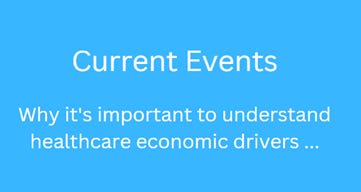Why it's important to understand healthcare economic drivers ...
Political prognosticators address the affordability of healthcare but don't address the economic drivers raising affordability issues which the public must understand
This post is created for use by journalists, influencers, and leadership to ponder the basic economic drivers of healthcare cost.
Understandably everyone wants to see healthcare available for all people.
For this to happen, however, we need to understand the economic drivers in play that effect the cost and availability of healthcare services.
A conundrum exists between the intention to provide versus the availability of resources to accomplish this.
Most of the factors involved in determining healthcare cost are rarely presented in our political discourse.
This blog post will provide a summary of important areas for public discussion in order to understand the solution.
For a more comprehensive overview of healthcare in the US, suggest the Wikipedia page:
Here’s a preliminary list of the economic drivers:
Demographics
The age makeup of the population is important especially with an aging population. As people live longer in retirement, their savings may not be sufficient to pay for their longer life spans which require more healthcare services.
Likewise, family size effects cost to the family income provider.
Technology
Advances in technology besides providing more options for addressing medical conditions nevertheless increases the cost of healthcare. For example, items like open heart surgery, knee and hip replacements, radiation devices used to cure various forms of cancer, and the development of new drug therapies.
The availability of these advances raised healthcare cost.
End of life
It has been estimated that 30%+ of all current healthcare cost are for the last days of life as doctors try to save patients with terminal illnesses with experimental cures.
The discussion of rising healthcare cost must also be seen in light of the demographics of population growth especially a rising number of elderly.
Population growth
As the population grows beyond replacement levels, healthcare cost rises. In other words, families with more than two children will require more funding for healthcare for larger families.
Interestingly, the healthcare insurance companies know the cost of the above but are only presenting the aggregate cost to the consumer in their advertised premiums without exposing the above economic drivers.
The average per capita healthcare cost in America varies from approximately $7,000 to $14,000. This article was used as reference:
For any successful healthcare reform, the consumer of the services must recognize the above economic cost drivers in order to understand why the cost of healthcare is rising and to understand their behaviors that will make use of the available resources to the number of people requiring the services.
For a long-term solution to providing healthcare to all people in America, these factors need to be discussed and understood for a sustainable solution
Additionally, journalists, leadership, and other influencers need to provide the public summary data to fully grasp the total spending required to meet the healthcare intention of covering all people.
My Substack posts are not meant to be extensive and are only to provide the readers a preliminary overview to ponder the basic economics in play including the economic drivers increasing healthcare cost.
I’m on both social media platforms Bluesky and X (formerly Twitter) where you can leave comments and suggestions for this blog post.
Thanks for your time.
Note: the majority of links presented in this post not bolded are from Wikipedia if the reader wishes to explore the terms in greater depth to which I also recommend you have software that protects you from high-risk websites. Bolded links are my other previous Substack blog posts.




